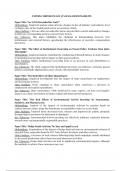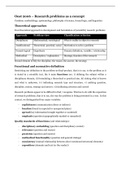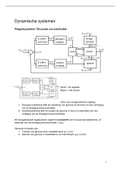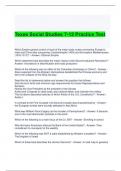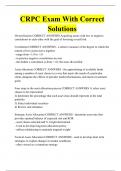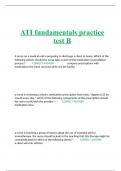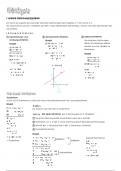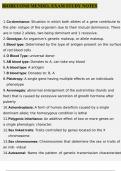Chapter 2 page 31-56
Disease
Disease is dysfunction of an organ or tissue caused by damage to the cells. The damaging agent is
the etiology, the influence on the changes in the cells reflects the pathogenesis. Multicellular
individuals have an optimized internal milieu, and thus attractive to intruders. A defense is required
to fight infectious disease. Organization and clear division of tasks is mandatory, for example
regulation of proliferation cancer.
Cell injury
Hypoxia and ischemia
= oxygen deficiency and reduced blood supply. Cells subjected to hypoxia that do not immediately
go into necrosis have a compensatory mechanism induced by HIF-1 = stimulates synthesis survivor
proteins as VEGF (=growth vessels). Persistent / severe hypoxia and ischemia lead to failure ATP
generation and depletion ATP in cells. Causing cell swelling by inactivity pumps, lactic acid
accumulation, ROS increase and irreversible damage mitochondria and lysosomes.
Under certain circumstances restoration of blood flow through ischemic tissue increases cell injury =
ischemia-reperfusion injury increased ROS by damaged cells, antioxidant mechanisms
compromised, enhanced influx leukocytes which products may cause more damage, also
complement.
Oxidative stress
= cellular abnormalities induced by ROS. They are produced by 2 major pathways: Redox-reactions
during mitochondrial respiration and energy generation. Phagocytic leukocytes used as
weapon for destroying microbes. The generation is increased by inflammation. Causes damage to
DNA, changes proteins and membranes.
Toxins and ER stress
Different types of toxins work via 2 mechanisms: direct acting toxins = combining with critical
molecular component / organelle. Latent toxins = first converted to active metabolite, by
cytochrome P-450 in liver. Accumulation misfolded proteins can stress compensatory pathways in ER
and lead to apoptosis. If there is accumulation a unfolded protein response is started increased
chaperone production and decreased protein translation. If too much, BH3 will be activated and
apoptosis.
Damage DNA sensed and leads to accumulation p53 arrests cell at G1 to allow repair, if damage is
too great apoptosis triggered by BH3 stimulation. If p53 is absent cell will survive, leading to cancers.
Cell adaptations
The cell or organ reacts to minimize impact of damage = adaptation. Therefore damage can be
reversible and lead to adaptation or cell death. There are different methods of adaptation:
Hypertrophy = increase in cell size tissue unable of division and by stimulation of GH or
mechanical stress e.g. myocyte under high BP
Hyperplasia = increase in number of cells cells able to divide physiological 2 types
o Hormonal hyperplasia = female breast growth pregnancy
o Compensatory hyperplasia = residual tissue growth after remove part of organ, liver
, Atrophy = decrease of cell size / number decreased nutrient supply and increased
breakdown e.g. brain with larger sulci by Alzheimer’s, autophagy, apoptosis and degrade
Metaplasia = replacement of one tissue by another response to irritation by altered
differentiation pathway stem cell e.g. squamous bronchial epithelium in smokers, no cilia
and many cell layers
Cell death
Cell damage caused by oxygen shortage causing the cell to swell by failure of Na-K-ATPase unable
to remove excess water from cells. In the beginning this is reversible and cells will recover, differs
between cells how long they can go without oxygen. 2 ways in which cells can die:
Necrosis = always caused by outside triggers pro-inflammatory, induces repair and
defense, cell content released extracellularly, no regulation and pathologic
o coagulation necrosis = structure still visible, blocked proteolysis, many tissues
o colliquative necrosis = liquefactive, making hole of pus, CNS hypoxia
o gangrenous necrosis = limb lost blood supply, coagulative necrosis into liquid
o caseous necrosis = yellow / white holes like cheese, seen in TBC
o fat necrosis = white deposits by lipases into peritoneal cavity, by acute pancreatitis
o fibrinoid necrosis = looks like fibrin in arterial wall, occurs in immune reactions
Apoptosis = usually triggered from inside cell anti-inflammatory, no induction of repair,
cell contents released in surroundings, cellular suicide strictly regulated, physiological and
continuous process
Apoptosis
Apoptosis occurs in embryonal development, for normal tissue homeostasis, the selection of
lymphocytes, involution of atrophy (endometrium during period), termination inflammatory
response, elimination virus-infected cells or stressed (by NK cells) or damaged. There are two
pathways:
Mitochondrial intrinsic = cell deprived of GF and survival signal, BH3 sensor activated which
shifts Bcl-2 into Bax and Bak dimerize and into mitochondria forming channels to leak
cytochrome C mitochondrial membrane becomes permeable and leaks cytochrome c
activates capsace-9 activating caspase cascade
Death receptor extrinsic = TNF or Fas activated by FasL on T lymphocytes adaptor
proteins caspase-8 activation and caspase cascade
There is a loss of apoptosis-response by overexpression of BCL-2 gen by translocation. Cells no
longer undergo apoptosis and causes tumor follicular lymphoma.
Cytochrome C = function is induction of apoptosis. Binds to Apaf-1 forming heptamer complex
binding procaspase-9 and ATP, this starts the caspase cascade. The intracellular phosphatidylserine
flips extracellular and recognized by macrophages, leading to phagocytosis. Annexin V = fluorescent
die which can bind to this to make apoptotic cell visible.
Necroptosis = no necrosis and no apoptosis, little inflammation in between the others. By
stimulation TNF and other triggers cause dissolution of cell like necrosis. Pyroptosis = activation
cytosolic danger-sensing protein complex (inflammasome), giving caspase activation, inflammation
and apoptosis. Autophagy sometimes used under stress, lysosomal digestion cell’s own components.
if too much results in apoptosis.



